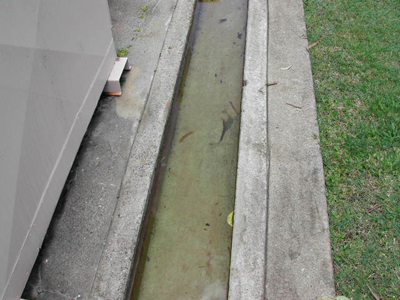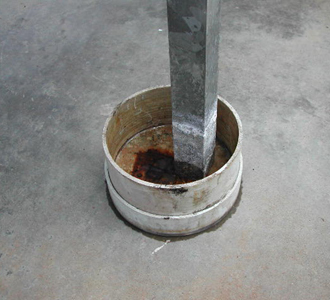|

A water-filled moat surrounding a mass rearing
facility
for excluding incursion by ants and other insects.
|
Insectaries
Although some agents can be reared in outside cages or in the field, others require the protection of insectaries against predators, parasites, extremes of ambient temperatures or rain to maximise production. Generally, an insectary should be a screened, ant-proof building which allows air flow, contains escaped insects, and keeps predators and parasitoids away from the rearing colony.
Provision of means of control of temperature, photoperiod and, perhaps, humidity allow optimal conditions for the insects to be maintained, thus maximising the numbers of agents produced and avoiding delays due to
diapause.
Ant-proofing
Ants are a problem in insect rearing because they:
 | colonise the soil in pots, trays and in the ground; |
 | attack the insects being reared; |
 | actively culture pest insects such as aphids, scales and mealybugs which make the host plants unsuitable for the agent insects. |
|
|

A bench leg in a container of water to prevent
incursion by ants.
|
Ants can be excluded using water-filled moats around concrete slabs or building piers, or by placing the legs of benches in containers of water.
Host plants should be grown in an area protected from ants to avoid bringing ant-infested pots into the
insectary. Ant-infested pots can be disinfested by leaving them submerged in tubs of water for 24 hours. Sufficient detergent or wetting agent should be added to enable the water to penetrate the soil fully and to wet the integument of the ants.
Cages
Cages can be made of the most economical materials available. Wire and fibreglass fly netting, some fabrics and mosquito netting are useful cage materials. Frames are often made of wood, stiff wire, aluminium or steel. Plastic food containers can make ideal small cages. Cages should be designed to suit the host plants, the insects and the health and safety of insectary workers. When plants are going to be in a cage for an extended time the covering should transmit sufficient light for photosynthesis to occur.
In some cases an entire insectary or other structure such as a shadehouse can be used as a large cage.
|

